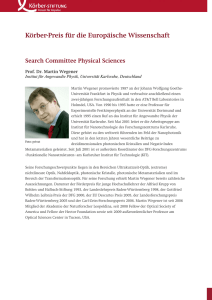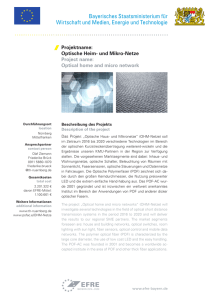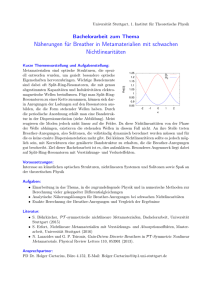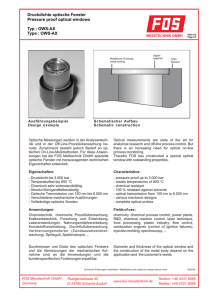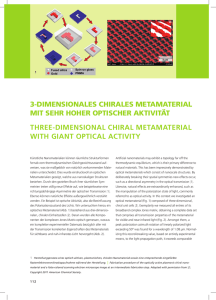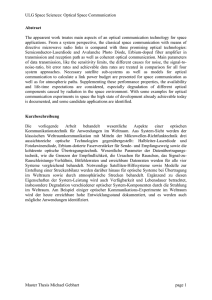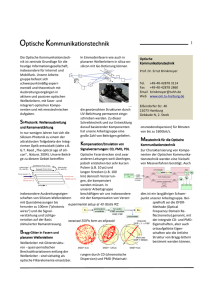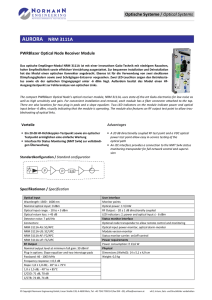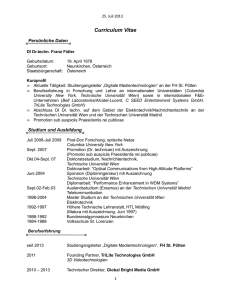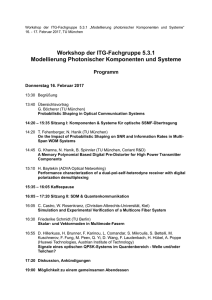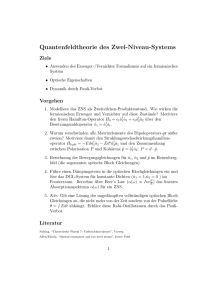Polarisations-unsensitive optische Metamaterialien
Werbung
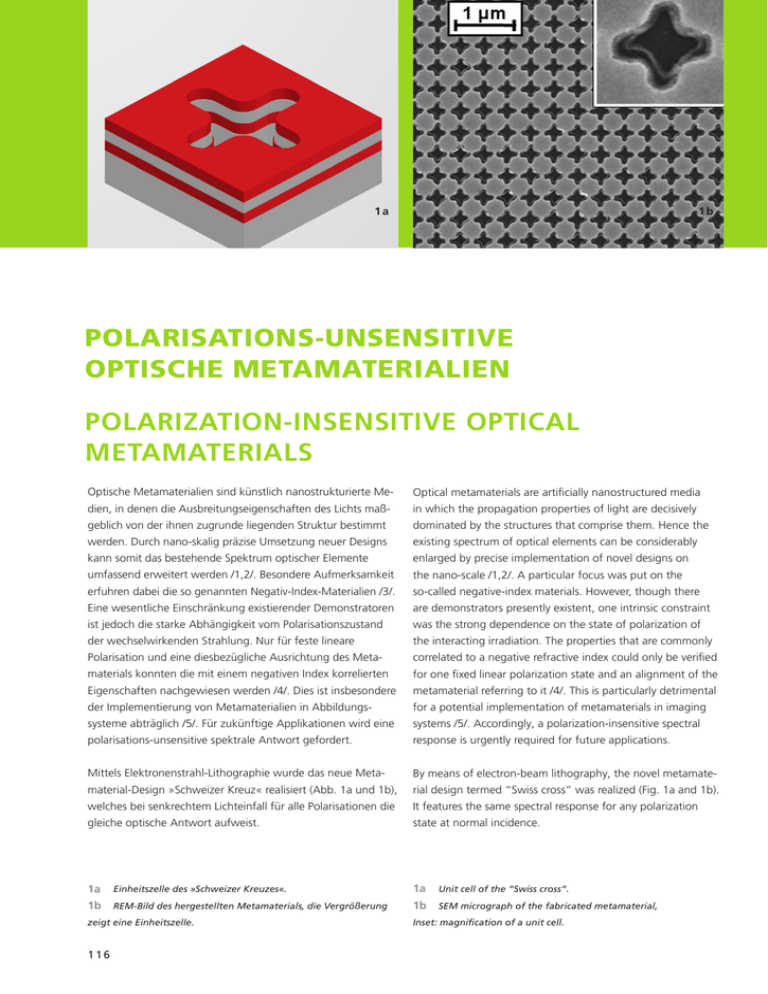
1a 1b Polarisations-unsensitive optische Metamaterialien Polarization-insensitive optical metamaterials Optische Metamaterialien sind künstlich nanostrukturierte Me- Optical metamaterials are artificially nanostructured media dien, in denen die Ausbreitungseigenschaften des Lichts maß- in which the propagation properties of light are decisively geblich von der ihnen zugrunde liegenden Struktur bestimmt dominated by the structures that comprise them. Hence the werden. Durch nano-skalig präzise Umsetzung neuer Designs existing spectrum of optical elements can be considerably kann somit das bestehende Spektrum optischer Elemente enlarged by precise implementation of novel designs on umfassend erweitert werden /1,2/. Besondere Aufmerksamkeit the nano-scale /1,2/. A particular focus was put on the erfuhren dabei die so genannten Negativ-Index-Materialien /3/. so-called negative-index materials. However, though there Eine wesentliche Einschränkung existierender Demonstratoren are demonstrators presently existent, one intrinsic constraint ist jedoch die starke Abhängigkeit vom Polarisationszustand was the strong dependence on the state of polarization of der wechselwirkenden Strahlung. Nur für feste lineare the interacting irradiation. The properties that are commonly Polarisation und eine diesbezügliche Ausrichtung des Meta- correlated to a negative refractive index could only be verified materials konnten die mit einem negativen Index korrelierten for one fixed linear polarization state and an alignment of the Eigenschaften nachgewiesen werden /4/. Dies ist insbesondere metamaterial referring to it /4/. This is particularly detrimental der Implementierung von Metamaterialien in Abbildungs­ for a potential implementation of metamaterials in imaging systeme abträglich /5/. Für zukünftige Applikationen wird eine systems /5/. Accordingly, a polarization-insensitive spectral polarisations-unsensitive spektrale Antwort gefordert. response is urgently required for future applications. Mittels Elektronenstrahl-Lithographie wurde das neue Meta- By means of electron-beam lithography, the novel metamate­ material-Design »Schweizer Kreuz« realisiert (Abb. 1a und 1b), rial design termed “Swiss cross” was realized (Fig. 1a and 1b). welches bei senkrechtem Lichteinfall für alle Polarisationen die It features the same spectral response for any polarization gleiche optische Antwort aufweist. state at normal incidence. 1a Einheitszelle des »Schweizer Kreuzes«. 1a Unit cell of the “Swiss cross”. 1b REM-Bild des hergestellten Metamaterials, die Vergrößerung 1b SEM micrograph of the fabricated metamaterial, zeigt eine Einheitszelle. Inset: magnification of a unit cell. 116 Grundlagen FUNDAMENTALS Die Polarisationsunabhängigkeit basiert auf der Symmetrie der The independency of polarization is based on symmetry Einheitszelle und wurde experimentell bis auf geringfügige considerations of the unit cell and was experimentally proved herstellungsbedingte Abweichungen durch spektroskopische by spectroscopic measurements within the limits of minor Messungen bestätigt (Abb. 1c und 1d). Dabei konnte eine manufacturing deviations from an ideal sample (Fig. 1c and exzellente Übereinstimmung zwischen Experiment und Theorie 1d). Excellent agreement between experiments and theory nachgewiesen werden (Abb. 1e). Insbesondere weist das was found (Fig. 1e). In particular, the ‘Swiss cross’ shows a »Schweizer Kreuz« einen effektiven negativen Brechungsindex negative index of refraction of n = -1.9 at a wavelength of von n = -1,9 bei einer Wellenlänge von λ = 1400 nm auf λ = 1400 nm (Fig. 1f). The universality of this property for all (Abb. 1f). Die Universalität dieser Eigenschaft für alle Pola- states of polarization at normal incidence constitutes a novelty risationszustände bei senkrechtem Einfall ist ein Novum für in the optical spectral domain /6/. Metamaterialien im optischen Spektralbereich /6/. 1 c) Transmission und d) Reflexion in Abhängigkeit der Wel- 2 Gemessene Transmissionspektren des »Schweizer Kreuzes« lenlänge λ und dem Polarisationswinkel. e) Vergleich von ge- in Abhängigkeit von der Wellenlänge λ und dem Polarwinkel θ. messenen und simulierten Transmissions- und Reflexionsspek- Bezüglich Polarisation und Azimutwinkel φ werden vier Fälle un- tren für senkrechten Einfall. f) Aus den numerischen Daten terschieden: a) TE-Polarisation und φ = 0°; b) TM-Polarisation und errechneter Real- und Imaginärteil des Brechungsindexes. / φ = 0°; c) TE-Polarisation und φ = 45°; d) TM-Polarisation und c) Transmission and d) reflection in dependence of wavelength φ = 45°. / Measured transmission spectra of the ”Swiss cross” in λ and polarization angle. e) Comparison of measured and dependency of wavelength λ and polar angle θ. 4 cases concerning simulated transmission spectra for normal incidence. f) Real polarization and azimuth angle φ have to be distinguished: and imaginary part of the refractive index retrieved from the a) TE-polarization and φ = 0°; b) TM-polarization and φ = 0°; c) calculated data. TE-polarization and φ = 45°; d) TM-polarization and φ = 45°. 117 An diesem Metamaterial wurde erstmalig die Abhängigkeit For the first time, the dependence of a negative index on the eines negativen Brechungsindexes vom Einfallswinkel des angle of incidence of the incoming light could be examined Lichts experimentell und theoretisch untersucht /7/. both experimentally and theoretically on the example of this Das Winkelspektrum ist für Abbildungssysteme auf der Basis metamaterial /7/. Generally, the angular spectral response is optischer Metamaterialien von hoher Relevanz. Im vorliegen- highly relevant for imaging systems on the basis of optical den Fall wurden der Azimutwinkel φ und die Polarisation des metamaterials. In the case under consideration, the azimuth einfallenden Lichts festgehalten und der Polarwinkel θ und die angle φ and the polarization of the incoming light were fixed Wellenlänge λ als freie Parameter variiert. Abbildung 2 zeigt while the polar angle θ and the wavelength λ were varied as exemplarisch die Transmissionsmessungen für vier Winkel- und free parameters. Figure 2 exemplarily shows the transmission Polarisationskonfigurationen des »Schweizer Kreuzes«. measurements of the “Swiss cross” for four configurations of angles and polarization states. Aus diesen Ergebnissen können am Beispiel dieses optischen Metamaterials erstmalig Schlüsse über die Winkelabhängigkeit Basing on these results and for the first time, it was possible der zugewiesenen effektiven Materialeigenschaften gezogen to draw conclusions concerning the angular dependency of werden. Abbildung 3 zeigt exemplarisch den Realteil des the effective properties that are commonly ascribed to optical effektiven Brechungsindexes in Abhängigkeit von Polarwinkel metamaterials. Figure 3 depicts exemplarily the real part of the θ und Wellenlänge λ für einige ausgewählte Konfigurationen effective index of refraction in dependency on the polar angle /8/. Diese Abhängigkeiten des Indexes suggerieren dessen θ and the wavelength λ for chosen configurations /8/. Verständnis als einen »Wellen-Parameter«, der die Lichtpropa- This dependency of the index suggests that it should be gation in Metamaterialien modellhaft beschreibt /9/. Er kann considered a “wave-parameter” which may model the light somit nicht als eine explizit dem Metamaterial zugeordnete propagation in optical metamaterials. Contrary to its interpre- Eigenschaft verstanden werden, im Gegensatz zu seiner tation for classical optical media, it may not be understood as Interpretation für klassische optische Medien. Die Erforschung a property explicitly linked to the metamaterial itself. In light der Grundlagen optischer Metamaterialien wird daher auch of these findings, it becomes clear that the exploration of the in den kommenden Jahren noch spannende Fragestellungen fundamentals of optical metamaterials will give rise to further aufwerfen. exciting questions in the years to come. 118 Literatur/References /6/ Helgert, C.; et al.: Polarization independent negative-index /1/ Pendry, J.; et al.: Controlling Electromagnetic Fields, metamaterial in the near-infrared, Opt. Lett. 34, 704 (2009). Science 312, 1780 (2006). /7/ Menzel, C.; et al.: Retrieving effective parameters for /2/ Leonhardt, U.: Optical Conformal Mapping, Science 312, metamaterials at oblique incidence, Phys. Rev. B 77, 1777 (2006). 195328 (2008). /3/ Shalaev, V.: Optical negative-index metamaterials, Nat. /8/ Menzel, C.; et al.: Angular resolved effective optical Phot. 1, 41 (2007). properties of a Swiss cross metamaterial, Appl. Phys. Lett. 95, /4/ Dolling, G.; et al.: Simultaneous Negative Phase and Group 131104 (2009). Velocity of Light in a Metamaterial, Science 312, 892 (2006). /9/ Rockstuhl, C.; et al.: Light propagation in a fishnet meta- /5/ Pendry, J.: Negative Refraction Makes a Perfect Lens, material, Phys. Rev. B 78, 155102 (2008). Phys. Rev. Lett. 85, 3966 (2000). AUTHORS Christian Helgert1 Christoph Menzel2 Carsten Rockstuhl2 Ernst-Bernhard Kley1 Falk Lederer2 Thomas Pertsch1 Andreas Tünnermann1,3 Institut für Angewandte Physik, 1 Friedrich-Schiller-Universität Jena Institut für Festkörpertheorie und 2 -optik, Friedrich-Schiller-Universität Jena 3 Aus den numerischen Daten errechneter Realteil des effekti- Fraunhofer IOF 3 ven Brechungsindexes für vier Fälle wie in Abb. 2. Die schattierten Regionen indizieren Bereiche, in denen höhere Beugungsordnungen propagieren. / Real part of the effective refractive index retrieved from numerical data for the 4 cases as in Fig. 2. CONTACT The shaded areas indicate regions in which non-zero diffraction Prof. Dr. Thomas Pertsch orders propagate. Phone: +49 3641 947 840 [email protected] 119
